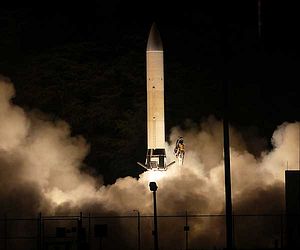Last week the Army announced it will conduct the second test of one of its hypersonic missiles in August.
Lt. Gen. David L. Mann, commander, U.S. Army Space and Missile Defense Command, told Congress last week that in August the Army expects to conduct the second Advanced Hypersonic Weapon Technology Demonstration. The results of this second test will determine the future of the program, which could include the U.S. Navy utilizing the new missile, according to Lt. Gen. Mann.
The Advanced Hypersonic Weapon (AWH) is part of the U.S. military’s conventional prompt global strike (CPGS) program, which aims to give Washington the ability to strike any target on earth with a conventional warhead within an hour’s time. According to the U.S. Army, “The AHW can be launched from the United States and can hit a target anywhere in the world. It can travel at speeds of Mach 5, about 3,600 mph, or higher.”
The AWH was first tested back in November 2011. It was launched at the Pacific Missile Range Facility in Kauai, Hawaii and traveled about 2,500 miles in about a half hour before reaching its target at the Reagan Test Site, U.S. Army Kwajalein Atoll in the Marshall Islands.
At the time of the test back in 2011, the Pentagon said: “A three-stage booster system launched the AHW glide vehicle and successfully deployed it on the desired flight trajectory. The vehicle flew a non-ballistic glide trajectory at hypersonic speed to the planned impact location at the Reagan Test Site. Space, air, sea, and ground platforms collected vehicle performance data during all phases of flight.”
Mann also confirmed that the AWH is on budget and said he doesn’t envision any cost overruns in the near future. “I don’t see any kind of an overrun at this moment…. Everything is kind of predicated on what happens after the test. We have the monies allocated to support the test. We don’t envision any kind of overruns.”
AWH is largely seen as being more successful than other programs in the CPGS program. Those programs are the Air Force’s Conventional Strike Missile (CSM) and the DARPA/Air Force HTV-2 program. The U.S. Air Force is exploring hypersonic technology as well via its experimental X-51A Waverider program. The U.S. Navy is also exploring the possibility of developing a submarine-launched hypersonic missile, although that might be based on existing CPGS technology such as the AWH.
The AWH missile would be an integral part of the U.S. military’s efforts to overcome China’s anti-access/area denial (A2/AD) strategy, given its ability to operate at far distances, penetrate contested environments and strike with precision. However, the U.S. also has to contend with Chinese and Russian programs to develop hypersonic missiles.
































